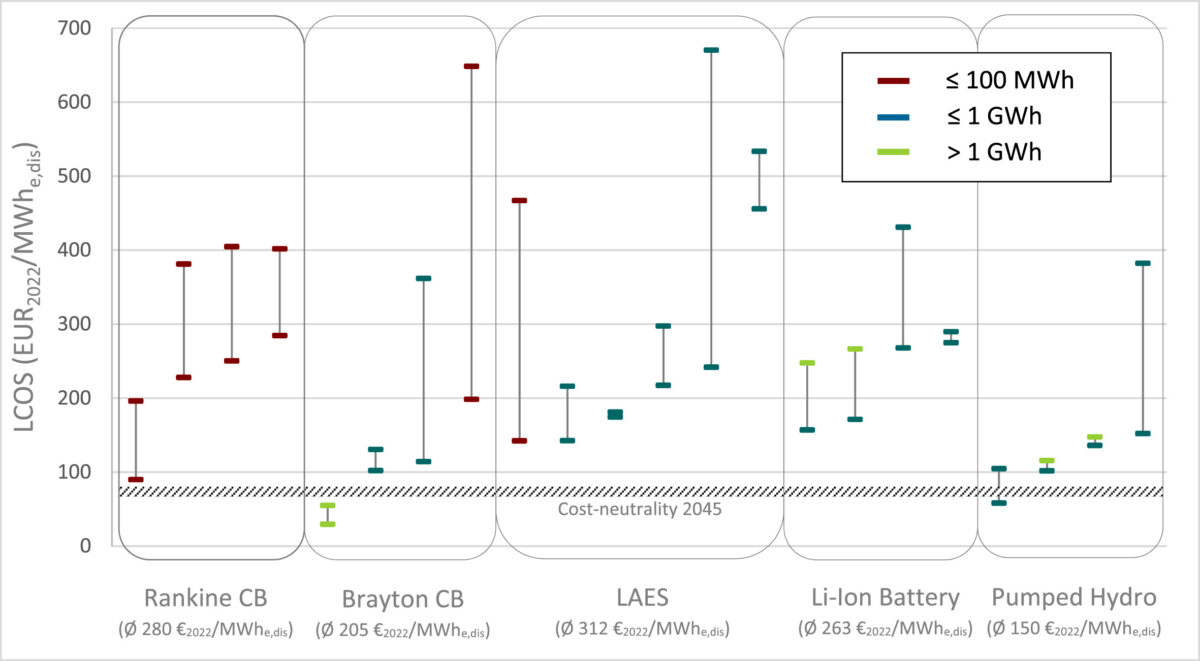Researchers in Denmark have investigated what levelized cost of storage (LCOS) Carnot batteries have to achieve to become competitive in a 100% renewables scenario within their home country. They found that these storage systems should have an LCOS lower than €66.2 ($72.07)/MWh, provided that gas prices stay at low levels.
Carnot batteries are systems that store electricity in the form of heat through storage media such as water or molten salt and transform the heat back to electricity when needed. This category includes liquid air energy storage (LAES) systems and Brayton or Rankine based pumped thermal energy storages (PTES) systems, as well as Lamm-Honigmann storage, which is a sorption-based technique that can be charged and discharged with both heat and electrical power, and systems based on integrated resistive heating with power cycles.
All these storage technologies, according to the research team, allow a broad range of applications such as arbitrage business, ancillary services, or peak shaving within power networks. “Additionally, the readily available hot and cold storages are unique features of Carnot batteries enabling multi-energy flexibility through the external use and integration of hot and cold recycle streams,” they explained.
The group sought to assess the economic feasibility of Carnot batteries in a 100% renewable energy scenario applied to Denmark by 2045. The scenario assumes that 14 GW of offshore wind power, 5 GW of onshore wind power, and 10 GW of PV are installed in the country, with around 70% of the primary energy demand comprising electricity, heating, cooling, transport, and process heating demands being covered by clean energies.
Furthermore, the energy system is assumed to rely on 4.8 GW of electrolysis capacity, 6 GW of transmission capacity, a maximum of 2 GW of charge capacity for Carnot batteries, and 4.8 GW of combined heat and power (CHP) plants. “As Carnot batteries are expected to be used for storage within a maximum of a few weeks, the maximum storage capacity tested is 7 days of full charging,” the scientists said.
Popular content
They used the EnergyPLAN simulation software to determine the renewable energy generation capacities, economic costs, and supply strategies needed to balance the projected future electricity demand in Denmark. In the simulation, Carnot batteries were modeled as stand-alone batteries, without potential heat output for district heating or industrial purposes.
Through their simulation, the researchers found that Carnot batteries may become economically feasible if their LCOS is lower than €66.2 ($72.07)/MWh, which they said includes the total expenditure over their full lifetime. This value, however, was calculated assuming a gas price of €9.3/GJ. “If the gas price would reach electro-methane levels the LCOS range would instead be around €119–130/MWh,” they also explained. “If the potential cost reduction is instead identified based on reducing capacities for electrolysis and hydrogen storage the LCOS drops to €38–43/MWh, depending on the cost of these components.”
The group also noted that currently, only one Carnot battery system concept has been identified with an LCOS lower than the €62/MWh. “Existing concepts for stand-alone Carnot batteries are not able to achieve these costs today, therefore solutions for cost reductions should be investigated,” they concluded.
The researchers presented their findings in the study “Economic potentials of carnot batteries in 100% renewable energy systems,” which was recently published in Energy. The team comprises academics from the Aalborg University and Technical University of Denmark.
This content is protected by copyright and may not be reused. If you want to cooperate with us and would like to reuse some of our content, please contact: editors@pv-magazine.com.



1 comment
By submitting this form you agree to pv magazine using your data for the purposes of publishing your comment.
Your personal data will only be disclosed or otherwise transmitted to third parties for the purposes of spam filtering or if this is necessary for technical maintenance of the website. Any other transfer to third parties will not take place unless this is justified on the basis of applicable data protection regulations or if pv magazine is legally obliged to do so.
You may revoke this consent at any time with effect for the future, in which case your personal data will be deleted immediately. Otherwise, your data will be deleted if pv magazine has processed your request or the purpose of data storage is fulfilled.
Further information on data privacy can be found in our Data Protection Policy.